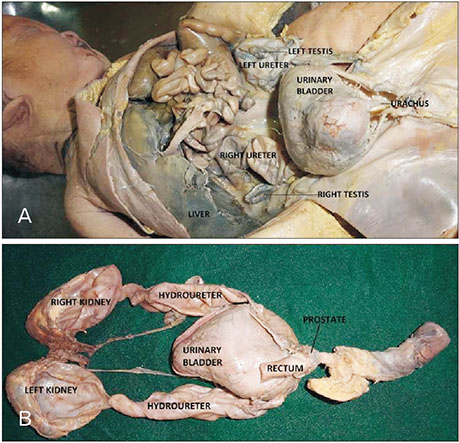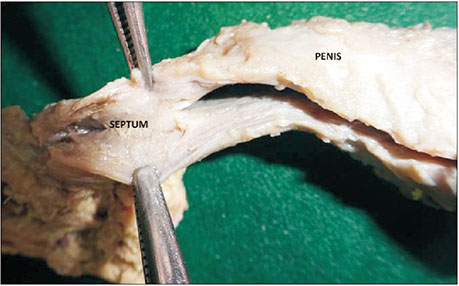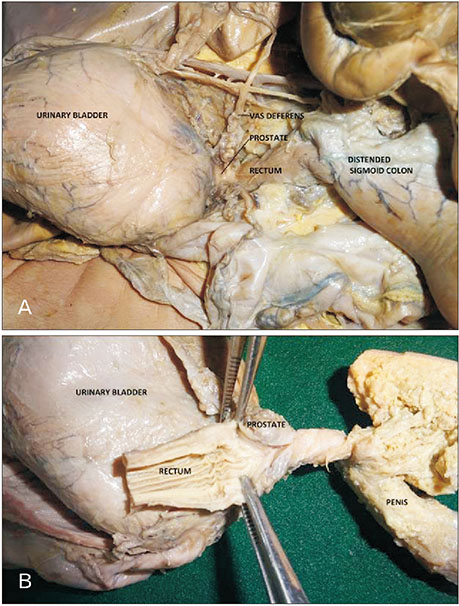Anat Cell Biol.
2018 Sep;51(3):205-208. 10.5115/acb.2018.51.3.205.
Exploration of the fetus with gross anomaly: a case of pseudo prune belly syndrome
- Affiliations
-
- 1Department of Anatomy, Jubilee Mission Medical College and Research Institute, Thrissur, India.
- 2Department of Anatomy, Kasturba Medical College, Manipal Academy of Higher Education, Manipal, India. ashwijas7@gmail.com
- KMID: 2447014
- DOI: http://doi.org/10.5115/acb.2018.51.3.205
Abstract
- Prune belly syndrome is a rare congenital anomaly usually presented with triad characteristic feature of deficient abdominal muscles, cryptorchidism, and urinary tract anomalies. Here, we present a case with all the characteristic features of prune belly and the associated secondary features which were observed on detailed dissection and exploration of the fetus.
MeSH Terms
Figure
Reference
-
1. Fette A. Associated rare anomalies in prune belly syndrome: a case report. J Pediatr Surg Case Rep. 2015; 3:65–71.
Article2. Randolph J, Cavett C, Eng G. Surgical correction and rehabilitation for children with “Prune-belly” syndrome. Ann Surg. 1981; 193:757–762.
Article3. Younous S, Zarrouki Y, Boutbaoucht M, Mouaffak Y, El Idrissi KE, Aboussair N, Saiad MO. Prune belly syndrome associated with full spectrum of VACTERL in a new born. J Clin Neonatol. 2012; 1:49–51.
Article4. Tagore KR, Ramineni AK, Vijaya Lakshmi AR, N B. Prune belly syndrome. Case Rep Pediatr. 2011; 2011:121736.
Article5. Leordean V, Lazăr D, Trofenciuc M. Morphological aspects in a urogenital malformation, complex and rare, in a child. Rom J Morphol Embryol. 2012; 53:421–425.6. Hong R, Whalen M, Casale P, Ruzal-Shapiro C. The erroneous diagnosis of prune belly syndrome in a case of posterior urethral valve. OMICS J Radiol. 2013; 2:132.7. Metwalley KA, Farghalley HS, Abd-Elsayed AA. Prune belly syndrome in an Egyptian infant with Down syndrome: a case report. J Med Case Rep. 2008; 2:322.
Article8. Haeri S, Devers PL, Kaiser-Rogers KA, Moylan VJ Jr, Torchia BS, Horton AL, Wolfe HM, Aylsworth AS. Deletion of hepatocyte nuclear factor-1-beta in an infant with prune belly syndrome. Am J Perinatol. 2010; 27:559–563.
Article9. Samal SK, Rathod S. Prune Belly syndrome: a rare case report. J Nat Sci Biol Med. 2015; 6:255–257.
Article10. Das Narla L, Doherty RD, Hingsbergen EA, Fulcher AS. Pediatric case of the day. Prune-belly syndrome (Eagle-Barrett syndrome, triad syndrome). Radiographics. 1998; 18:1318–1322.
Article11. Ramasamy R, Haviland M, Woodard JR, Barone JG. Patterns of inheritance in familial prune belly syndrome. Urology. 2005; 65:1227.
Article12. Fryns JP, Vandenberghe K, Van den Berghe H. Prune-belly anomaly and large interstitial deletion of the long arm of chromosome 6. Ann Genet. 1991; 34:127.13. Granberg CF, Harrison SM, Dajusta D, Zhang S, Hajarnis S, Igarashi P, Baker LA. Genetic basis of prune belly syndrome: screening for HNF1beta gene. J Urol. 2012; 187:272–278.14. Chai OH, Song CH, Park SK, Kim W, Cho ES. Molecular regulation of kidney development. Anat Cell Biol. 2013; 46:19–31.
Article15. Bellah RD, States LJ, Duckett JW. Pseudoprune-Belly syndrome: imaging findings and clinical outcome. AJR Am J Roentgenol. 1996; 167:1389–1393.
Article





